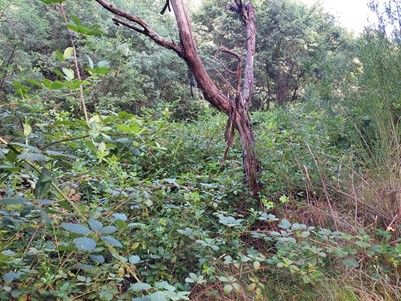Late in 2021 Parklands staff were excited to receive approval for a major recovery project in bushfire affected landscapes from Wodonga to the Upper Murray. Our Rangers hit the ground running, with a skilled Recovery Team providing on-ground support for volunteer groups and Landcare works across the region.
From fencing to tackling Weeds of National Significance, the team have delivered significant restoration and protection works in Wodonga’s regional parks including Baranduda and McFarlanes Hill Regional Parks and Swainsona Conservation Reserve.
The stock exclusion area at McFarlanes Hill Regional Park has been extended to remove grazing from six hectares of wet gullies and quality remnant eucalyptus treed areas. While replacing the boundary fence of the Swainsona Conservation Reserve, the Restoration team were able include an additional six hectares of Council reserve, thanks to Wodonga Council. This expansion of the 79 hectare Crown reserve includes remnant vegetation up to the top ridge and south facing slopes and further protects the endangered population of Smooth Darling Pea (Swainsona galegifolia).
Working with the Upper Murray community, the team fenced landscape scale wildlife corridors in Koetong, Shelley, Beetoomba, Berringama, Cudgewa Creek, Boundary Creek and Boggy Creek. These corridors allow regeneration of climate adapted native flora and provide safe passage for native fauna to travel and adapt to the changing climate.
The Recovery team also assisted the Upper Murray Landcare Network with plantings in environmental corridors on bushfire impacted farms in the Upper Murray. Due to Covid related delays and the extensive repairs necessary after the bushfires, many landholders were running out of time to plant the vast number of plants that were donated to restore their lost bushland. The Recovery team assisted Landcare Group members and landholders to plant and guard 11,265 seedlings at fifteen sites.
Project achievements include controlling environmental weeds, particularly Black willow, Blackberry and Rose briar in 350 hectares of quality Box Gum Grassy Woodlands and 21 hectares of waterways to remove competition with native species.
One hundred new squirrel glider nest-boxes, including 10 experimental boxes with different types of insulation, were installed, and 300 nest-boxes were monitored within the project area. Additionally, an efficient system for mapping and recording occupancy and maintenance was established using the freely available ArcGIS App, enabling volunteers to easily record their findings using their mobile phones.
The project also created a Ranger-led Box Gum Grasslands Stewardship program with on-ground sessions giving volunteers direct experience of habitat restoration, including the installation, maintenance and monitoring of nest boxes.
Parklands acknowledge the significant support of the Australian Government’s Bushfire Recovery Program for Wildlife and their Habitat in funding this Landcare Led Bushfire Recovery project.







